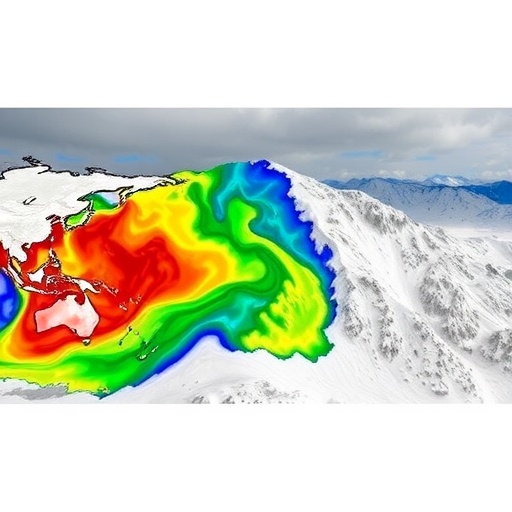A recent groundbreaking study has advanced our understanding of precipitation dynamics over the enigmatic and climatically vital Tibetan Plateau by integrating improved convective entrainment processes and orographic drag parameterizations within state-of-the-art weather modeling frameworks. Led by Dr. Junjun Li and a team of esteemed atmospheric scientists from multiple prestigious institutions, this research offers a transformative approach to simulating precipitation patterns in one of Earth’s most meteorologically complex regions, with profound implications for weather prediction and climate science.
The Tibetan Plateau’s topography and atmospheric interactions have long challenged meteorologists attempting to faithfully recreate its precipitation regimes. Traditional modeling efforts often suffer from biases that overestimate precipitation amounts, undermining accuracy and limiting forecast reliability. This new investigation leverages the Weather Research and Forecasting (WRF) model enhanced with an optimized Grell-Freitas cumulus convection scheme. Notably, this scheme incorporates an improved entrainment process — a mechanism by which environmental air is mixed into convective clouds — critical for realistic cloud development and precipitation generation.
In addition to refinements in convective entrainment, the study introduces a sophisticated Turbulent Orographic Form Drag (TOFD) parameterization into the WRF modeling system. Orographic drag represents the interaction between airflow and mountainous terrain, profoundly impacting atmospheric circulation, cloud formation, and precipitation patterns. Turbulent forms of this drag simulate the sub-grid scale processes producing momentum loss and turbulence generation that directly affect precipitation’s spatial distribution on the plateau.
The research team meticulously conducted multiple sensitivity experiments for June and July 2019, a crucial monsoon period over the Tibetan Plateau, to disentangle the separate and combined roles of the improved cumulus scheme and turbulent orographic drag. The baseline control simulation revealed a systematic overestimation bias of precipitation across the plateau and adjacent regions, consistent with known deficiencies in standard WRF configurations.
Remarkably, when the optimized Grell-Freitas cumulus scheme with enhanced entrainment was incorporated, the overestimation bias substantially diminished. This improvement manifested not only in the mean precipitation amounts but also in the temporal evolution and spatial heterogeneity of rainfall patterns. The refined scheme better captures the delicate balance of moist convection processes and the entrainment of drier air, which suppresses excessive precipitation often modeled by coarse parameterizations.
Conversely, the simulation employing only the Turbulent Orographic Form Drag parameterization rendered a nuanced impact. While the domain-averaged precipitation quantity showed limited change, the spatial fidelity of simulated precipitation improved significantly. This suggests that TOFD governs how precipitation is distributed according to intricate mountainous influences, underscoring the crucial role of orographic drag in modulating precipitation microphysics and mesoscale circulations.
The most compelling results emerged from the combined experiment, which synergized the improved convective scheme with the TOFD parameterization. This dual enhancement yielded the highest accuracy, marked by the greatest reduction in precipitation bias against satellite observations from the Global Precipitation Measurement (GPM) mission. The model outputs revealed enhanced skill scores, underscoring superior alignment with observed precipitation climatology and the temporal variability characteristic of the Tibetan monsoon.
These findings signify a pivotal leap in high-altitude weather modeling, as the researchers convincingly demonstrate that neither convective entrainment nor orographic drag can be neglected when striving for robust precipitation simulations in complex terrain. The interplay between microscale cloud processes and macroscale atmospheric drag mechanisms is paramount to capturing realistic precipitation signals in mountainous regions.
This holistic modeling improvement has widespread implications beyond academic meteorology. Improved precipitation forecasts over the Tibetan Plateau enhance hydrological predictions vital for water resource management in Asia, given the plateau’s role as the “Water Tower of Asia.” Better precipitation depictions also inform climate impact assessments, including glacial mass balance, ecosystem resilience, and risk evaluations for extreme weather events.
Additionally, the methodology and parameterization advancements presented in this research offer transferable insights applicable to other mountainous regions worldwide. The challenges posed by rugged topography and multiscale convective processes are universal, positioning this study as an exemplary blueprint for refining weather and climate models on a global scale.
The extensive evaluation against GPM satellite data affirms the model’s enhanced capability to reproduce both probability density functions and precipitation time series with fidelity. This rigorous validation underscores the robustness of the combined parameterization approach and its promise for operational forecasting systems.
Moreover, this integrative modeling strategy highlights the critical importance of advancing convective entrainment parameterizations in tandem with turbulent orographic drag treatments. Such synergistic improvements address longstanding discrepancies in precipitation forecasts, facilitating closer approximation of observed meteorological phenomena and reducing uncertainty in weather predictions.
In summation, this seminal study spearheaded by Dr. Junjun Li and colleagues elevates the precision of precipitation simulations over the Tibetan Plateau through a pioneering fusion of atmospheric parameterizations. By harmonizing enhanced convective processes and orographic drag mechanisms within the WRF model, the research sets a new benchmark in mountainous weather modeling. Its broad relevance spans meteorology, hydrology, and climate science, promising more accurate forecasting and informed decision-making in regions reliant on intricate precipitation processes.
The work exemplifies the power of interdisciplinary collaboration among leading institutions, integrating atmospheric physics, computational modeling, and observational validation to confront one of the greatest meteorological challenges of our time. As climate variability intensifies, such advances in high-resolution precipitation modeling are indispensable for safeguarding vulnerable populations and ecosystems dependent on the climatic stability of the Tibetan Plateau and beyond.
Subject of Research: Precipitation simulation improvements through combined convective entrainment and turbulent orographic drag parameterizations over the Tibetan Plateau.
Article Title: The combined effects of convective entrainment and orographic drag on precipitation over the Tibetan Plateau.
News Publication Date: 2025.
Web References: http://dx.doi.org/10.1007/s11430-024-1619-5
References: Li J, Lu C, Chen J, Zhou X, Yang K, Xu X, Wu X, Zhu L, He X, Wu S, Lin P. 2025. The combined effects of convective entrainment and orographic drag on precipitation over the Tibetan Plateau. Science China Earth Sciences, 68(8): 2615–2630. https://doi.org/10.1007/s11430-024-1619-5
Image Credits: ©Science China Press
Keywords: Tibetan Plateau, precipitation simulation, Weather Research and Forecasting model, convective entrainment, Grell-Freitas cumulus scheme, turbulent orographic form drag, mountain meteorology, climate modeling, satellite validation, hydrological forecasting.




